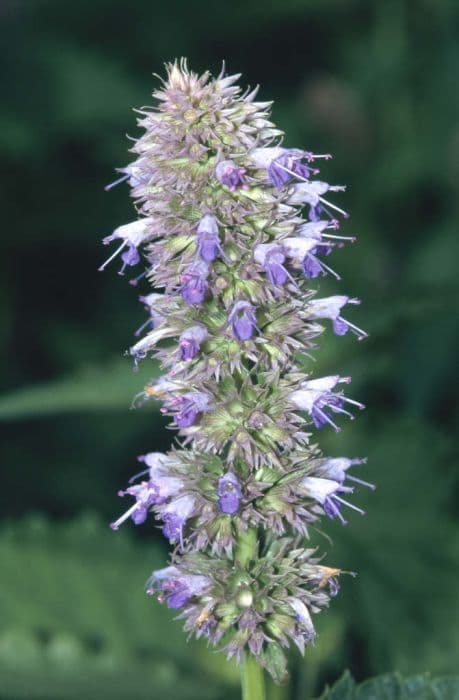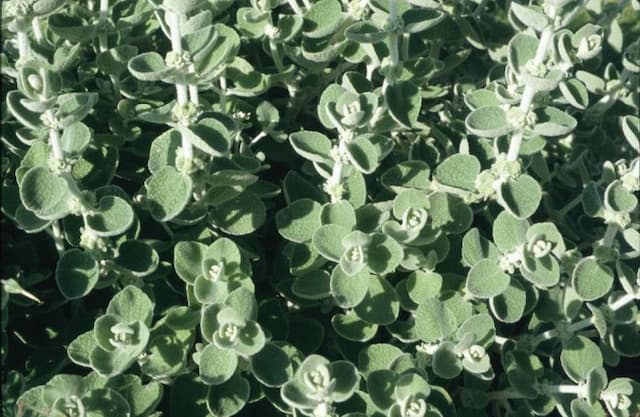Autumn Sage Salvia greggii 'Strawberries and Cream'

ABOUT
The Salvia greggii 'Strawberries and Cream', commonly known as Autumn Sage, is a visually striking plant with a distinct appearance. The foliage of this plant is composed of small, ovate leaves that are aromatic when crushed. The leaves exhibit a deep green color, providing a lush backdrop for the flowers. The most captivating feature of the Autumn Sage is its blossoms. The plant produces an abundance of flowers that embody the delightful hues suggested by its name 'Strawberries and Cream'. The flowers are tubular, with a bi-colored palette that merges the softness of creamy white with the warm vibrancy of strawberry pink. These blooms are arranged in loose whorls that climb up the flower stems, creating a bouquet-like effect that is both casual and elegant. The contrast between the pink and cream provides a nuanced visual effect, granting the plant an allure that can attract both gardeners and pollinators alike. The overall appearance is one of a bright and cheerful plant that can bring a splash of color to any garden setting.
About this plant
 Names
NamesFamily
Lamiaceae
Synonyms
Autumn Sage, Cherry Sage, Gregg's Sage, Texas Red Sage
Common names
Salvia greggii 'Strawberries and Cream'.
 Toxicity
ToxicityTo humans
Autumn Sage is generally not considered toxic to humans. However, ingesting large quantities of any plant material may cause gastrointestinal discomfort, such as nausea or vomiting in some individuals. It is always advisable to avoid consuming plants that are not specifically grown for human consumption to prevent any potential adverse reactions.
To pets
Autumn Sage is generally considered non-toxic to pets, including dogs and cats. However, as with humans, consuming large amounts of plant matter can lead to gastrointestinal upset in some animals. If a pet ingests a large portion of the plant and experiences symptoms such as vomiting or diarrhea, it is best to consult a veterinarian.
 Characteristics
CharacteristicsLife cycle
Perennials
Foliage type
Evergreen
Color of leaves
Green
Flower color
Pink
Height
2 feet (0.61 meters)
Spread
2 feet (0.61 meters)
Plant type
Shrub
Hardiness zones
8
Native area
Texas
Benefits
 General Benefits
General Benefits- Attracts Pollinators - The flowers provide nectar for bees, butterflies, and other beneficial insects.
- Drought Tolerance - Once established, it is highly tolerant of drought, requiring minimal supplemental water.
- Low Maintenance - Requires little care apart from occasional pruning to maintain shape and encourage blooming.
- Continuous Blooming - Prolific bloomer from spring through fall, offering long-lasting color in the garden.
- Deer Resistance - Generally resistant to browsing by deer, making it suitable for gardens in deer-prone areas.
- Compact Size - The plant remains fairly small, which makes it ideal for use in borders, containers, and small garden spaces.
- Landscape Versatility - Works well in various garden styles including rock gardens, xeriscapes, and cottage gardens.
- Fragrance - The leaves and flowers emit a pleasant scent, adding an aromatic dimension to the garden.
 Medical Properties
Medical PropertiesThis plant is not used for medical purposes.
 Air-purifying Qualities
Air-purifying QualitiesThis plant is not specifically known for air purifying qualities.
 Other Uses
Other Uses- Hummingbird Attractor: Salvia greggii is known for its ability to draw hummingbirds into the garden, providing essential nectar for these pollinators.
- Butterfly Garden Addition: The flowers serve as a nectar source for butterflies, making it a great addition to butterfly gardens.
- Culinary Garnish: The vibrant flowers can be used as an edible garnish on salads and desserts for a splash of color and a hint of flavor.
- Aromatic Sachets: The leaves of the Salvia greggii can be dried and placed in sachets to impart a pleasant fragrance in drawers and closets.
- Natural Dye: The flowers and leaves could potentially be used to create a natural dye for fabrics, though this is less commonly done.
- Photography Subject: The striking 'Strawberries and Cream' variety, with its gradient-colored flowers, is an excellent subject for botanical photography.
- Decorative Potpourris: Dried Salvia greggii flowers can be incorporated into potpourris to add fragrance and color to a room.
- Erosion Control: The plant can be used in landscapes to help stabilize soil and prevent erosion due to its woody stems and persistent nature.
- Floral Arrangements: Fresh or dried, the stems and flowers of Salvia greggii can be used to create vibrant, long-lasting floral arrangements.
- Educational Tool: In schools or botanical classes, Salvia greggii can be used to teach students about plant adaptation, pollination, and the life cycle of perennials.
Interesting Facts
 Feng Shui
Feng ShuiThe Autumn Sage is not used in Feng Shui practice.
 Zodiac Sign Compitability
Zodiac Sign CompitabilityThe Autumn Sage is not used in astrology practice.
 Plant Symbolism
Plant Symbolism- Healing: Salvias are commonly associated with healing due to their medicinal properties in various cultures.
- Wisdom: The name “Salvia” comes from the Latin word "salvere" meaning “to save,” hence it is often related to wisdom and knowledge.
- Longevity: Due to its hardy nature and long blooming period, the Autumn Sage reflects the symbolism of endurance and long life.
- Protection: The strong aromatic properties of many salvias lend them to associations with protection from negative influences.
 Water
WaterAutumn Sage should be watered deeply once a week during the growing season, allowing the soil to dry out between waterings to prevent root rot. The plant is drought-tolerant once established, typically requiring less water. If the weather is particularly hot and dry, it may need additional water. A good rule of thumb is to provide at least 1 inch of water every week, either through rainfall or supplemental watering. During the winter months when the plant is dormant, reduce watering significantly, providing just enough to keep the soil from becoming completely dry.
 Light
LightAutumn Sage thrives in full sun, needing at least 6 to 8 hours of direct sunlight each day to flourish and produce blooms. The best spot for Autumn Sage is in a location where it receives plenty of morning light and some protection from the intense afternoon sun, especially in areas with hot summers. Areas with bright light and some afternoon shade can also be suitable, providing a balance of light for optimal growth and flower production.
 Temperature
TemperatureAutumn Sage does well in a range of temperatures but prefers to be in conditions between 50°F and 90°F. It can tolerate temperatures down to about 10°F, making it a hardy choice for many gardening zones. The plant prefers warm days and cooler nights and is well-adapted to withstand the hot temperatures of arid and semi-arid climates.
 Pruning
PruningPruning Autumn Sage is essential to maintain its shape, encourage bushiness, and promote more vigorous blooming. Prune lightly in early spring to remove any frost-damaged stems and again in mid-summer to shape the plant and remove spent flowers. The best time for a more thorough pruning is late winter or early spring, before the onset of new growth, when you can cut the plant back by a third to promote fresh growth and flowers.
 Cleaning
CleaningAs needed
 Soil
SoilAutumn Sage requires well-draining soil with a slight preference for alkaline conditions, so a pH between 6.0 and 7.5 is ideal. A mix of regular potting soil, coarse sand, and compost works well. Amending the soil with perlite or small gravel can further improve drainage.
 Repotting
RepottingAutumn Sage doesn't need frequent repotting; once every 2-3 years suffices. Always use fresh, well-draining soil and ensure the new pot is slightly larger than the old one.
 Humidity & Misting
Humidity & MistingAutumn Sage thrives in moderate humidity environments; it does not require high humidity. Average room humidity is typically sufficient for this plant, but ensure good air circulation to prevent disease.
 Suitable locations
Suitable locationsIndoor
Autumn Sage needs bright light and occasional watering indoors.
Outdoor
Place Autumn Sage in full sun and well-draining soil.
Hardiness zone
6-9 USDA
 Life cycle
Life cycleSalvia greggii 'Strawberries and Cream', commonly known as Autumn Sage, begins its life cycle when seeds germinate in the spring, given appropriate warmth and moisture. The seedlings emerge and establish a root system, followed by the development of foliage — tender green leaves that harden as they mature. As it enters the vegetative stage, the plant experiences rapid growth of stems and leaves, preparing for the flowering stage. During the flowering period, which peaks in late spring to early summer and can continue into fall, the plant produces delicate flowers with a strawberry-and-cream appearance that attract pollinators. After pollination, seeds form and are eventually dispersed, enabling the continuation of the cycle. Autumn Sage, being a perennial, will then enter a period of reduced activity or dormancy in the winter, conserving energy for the next growing season.
 Propogation
PropogationPropogation time
Spring-Summer
The most popular method of propagating Salvia greggii 'Strawberries and Cream', also commonly known as Autumn Sage, is through semi-ripe cuttings. This typically involves selecting a healthy, non-flowering stem and cutting a piece about 4-6 inches (10-15 cm) long during the late spring or early summer when the plant’s growth is most vigorous. The lower leaves are removed, and the cut end is dipped in rooting hormone before being placed in a well-draining potting mix. The cutting should then be kept in a warm, humid environment with indirect light until roots develop, which usually takes a few weeks. Regular misting helps maintain appropriate humidity levels around the cutting. Once the roots are established, the new Autumn Sage can then be transplanted into the garden or a larger pot.









